 I’m a traditional illustrator, which means I don’t use anything vectorish (I don’t even know what that means), and I produce all my imagery using pencil, india ink and watercolour.
I’m a traditional illustrator, which means I don’t use anything vectorish (I don’t even know what that means), and I produce all my imagery using pencil, india ink and watercolour.
 I’m a traditional illustrator, which means I don’t use anything vectorish (I don’t even know what that means), and I produce all my imagery using pencil, india ink and watercolour.
I’m a traditional illustrator, which means I don’t use anything vectorish (I don’t even know what that means), and I produce all my imagery using pencil, india ink and watercolour.

I've recently spent some time getting to know the Canada Goose... see what I mean?
Another great day with the Calgary Pro Musica Society in the beautiful Rozsa Centre on the University of Calgary's campus!
Once again, I had the great fortune of organizing CPMS' craft room, and once again, my wonderful volunteers and I had hoards of artistic, craft-happy kids and parents come through before and after CPMS's two matinees.
This year, CPMS put on The Snow Queen as part of their children's series, so a craft that reflected the Hans Christian Andersen tale was in order.
I settled on articulated paper puppets as the craft which, for a number of reasons, was a good choice. Firstly, kids only have between 15 minutes and an hour to complete their craft. Secondly, paper puppets aren't terribly messy. Thirdly, kids love puppets.
And finally, the supply list is mercifully short...
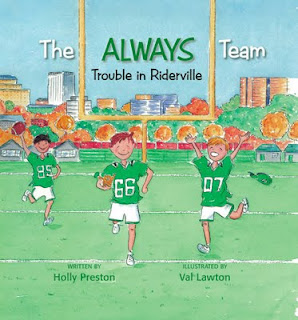 My most recent book-- and the latest Saskatchewan Roughrider book -- has rolled off the presses just in time for the annual Labour Classic Day CFL game, the much-loved duel between the Saskatchewan Roughriders and the Winnipeg Blue Bombers (Sunday, September 4 at Mosaic Stadium in Regina).
My most recent book-- and the latest Saskatchewan Roughrider book -- has rolled off the presses just in time for the annual Labour Classic Day CFL game, the much-loved duel between the Saskatchewan Roughriders and the Winnipeg Blue Bombers (Sunday, September 4 at Mosaic Stadium in Regina).
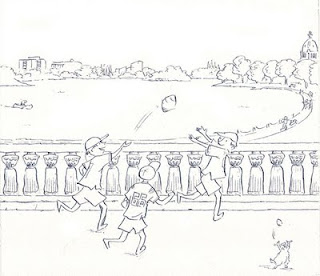
I've just returned from a revitalizing weekend at the magnificent Banff Centre for the Arts (the temperature was plus 1!), where I had an opportunity to facilitate a couple of workshops at the 6th annual Learning Through the Arts Banff Teacher Institute. There was lots of cross-pollination as LTTA artists and teachers from across Canada gathered in the mountains to share their arts-based ideas, innovations and experiences for the classroom.

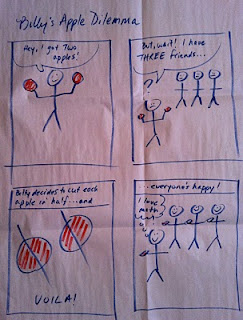
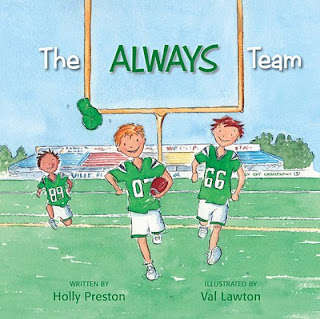
The Always Team is out in the world now, and less than 3 months after its debut, is very close to being sold out -- seems many people want a children's book about the Saskatchewan Roughriders (even if the 'Riders didn't take this year's Grey Cup back to Regina).
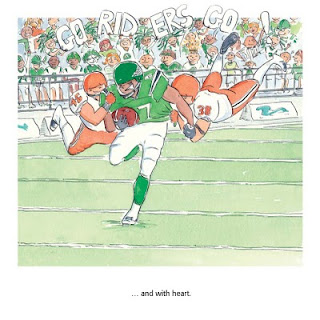
Not much longer now... I've spent much of June and July working away on The Always Team, a children's book about the Saskatchewan Roughriders. Now, we await the final product to be printed (it's at Friesens in Manitoba), packaged up and delivered into our anxious little hands.
One of the moms at my daughter's school asked me if I had any arty ideas for a surprise year-end gift for our kids' very special grade 4 teacher.
The teacher (whom I'll call Mrs Clark 'cause that's her name) is a believer in the connectedness of life, and subscribes to the what-comes-around-goes-around principle. She's also the kind of person who'd love a drawing done on the back of a paper serviette just so long as it comes from the heart.
What could be done, we wondered, that would include each of the students, yet not be too taxing on the kids and their families? The work on this project would have to be done on the homefront without Mrs Clark's knowledge.
We settled on a mandala, which in Sanskrit means "essence" and "having or containing," a symbol representing the entire universe, "the self and inner harmony,"as well as translating to "completion." Perrrr-fect!
Creating a mandala required some geometric figuring and cyphering on my part. With 18 kids in the class, and 360 degrees in a circle, each piece of the pie would have to be ... uh, hang on ... 20 degrees per piece.
So, onto 18 separate sheets of Arches 90 lb hot-pressed paper, I drew a 20-degree piece of pie, along with the delineations I wanted the kids to make, and a place for their name (all would have been lost without this step...).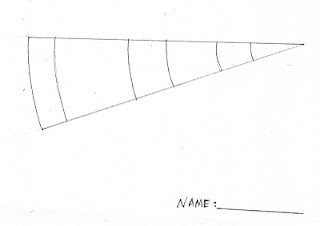
The other mom whom I'll call Charlotte ('cause that's her name), put together a secret little package of info for each kid to take home.
The package included this piece of pie (see right), a description of the project and what a mandala is, instructions to keep it SECRET, and an example of how they might colour their pie of the mandala (see below).
The toughest job was actually collecting the work from the kids without Mrs Clark knowing what was going on. This meant chasing kids down in the playground, e-mailing parents, peering into grubby backpacks, re-doing 20-degree pie pieces to no end, secret meetings, all in an effort to get the goods for the final piecing together of the mandala.
Once I had all the pieces collected, I used a larger piece of the Arches 90 lb paper, and glued them down to it , initially with a glue-stick. Then, I painted the entire surface with Modge Podge, being careful with the kids' art that was done in felt marker (for future reference, ask the kids to use only pencil crayon, no felts).
, initially with a glue-stick. Then, I painted the entire surface with Modge Podge, being careful with the kids' art that was done in felt marker (for future reference, ask the kids to use only pencil crayon, no felts).
Then, it was off to the framers' who cut a matte that overlapped the circumference of the mandala by a spare 1/16 of a inch. I chose a bright white matte and a simple black frame. To the back of the framed mandala, we attached a legend so Mrs Clark could see which mandala piece belongs to which student (hence the usefulness of keeping kids and pie pieces straight from the get-go).
The result is, well, pretty spectacular... or at least, we think so...
Another great Saturday spent with a couple of excited groups of Grades 4s and 5s, this time in High River, Alberta. The Foothills Young Authors' Conference is held annually at this time of year, and they always snag great keynote speakers. Thanks to all the organizers and sponsors of this event-- all the kids I talked to had a great time.
Kenneth Oppel came out from Toronto to attend this year's FYAC, and the line-up of kids wanting his autograph snaked back and forth around Centre Court at Highwood High School about half a dozen times. Some of the other great presenters I got a chance to rub shoulders with were Simon Rose, Hazel Hutchins, illustrator Derek Mah, BC writer John Wilson, Valerie Walker, Mar'ce Merrell, Donna MacNaughton and Jacqueline Guest.
My session was called The Art of the Picture Book, where I discussed how to tackle the job of illustrating a story-- the editing process, breaking copy into pages, pacing, page formatting, text placement, cover design, character consistency... all that good kind of stuff.
Th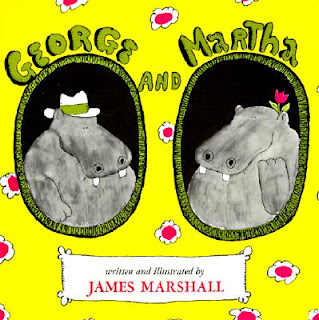 e kids' hands-on exercise was to illustrate a page based on copy borrowed from a scene in James Marshall's George and Martha (remember the one where George pours Martha's split-pea soup into his loafers?).
e kids' hands-on exercise was to illustrate a page based on copy borrowed from a scene in James Marshall's George and Martha (remember the one where George pours Martha's split-pea soup into his loafers?).
I put the copy up on the Smartboard, and let them go at it, reminding them that they had to plan for where the copy would sit on the page.
After they'd completed their illustrations, we compared and contrasted them with their classmates, and discussed their rationales. Most depicted George and Martha as humans, but there were also some aliens, dogs and amphibians.
I then showed them how Marshall had in fact depicted this scene, and since most kids (okay, none) weren't familiar with the story, none knew how he'd done it.
And none of them knew that the couple were hippos. Surprise!
See you all next year!
Another great day with a group of happy kids last weekend at one of Calgary's great independent bookstores -- Monkeyshines is the city's only kid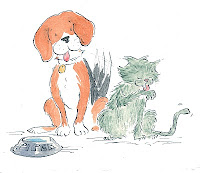 s-only bookstore.
s-only bookstore.
Owner Sue Hill and I came up with the idea of holding a sketch-your-pet workshop (I do have some experience in the pet sketching department).
The poster advertising the event (see image at right) asked kids to bring in pictures of their favourite pets, which most did.
I was also ready with pictures of my own that kids could choose from -- I had at-hand a picture of bull dog, a beagle or two, a couple of cats, a ferret, a hamster, and a gerbil (sorry, no reptiles).One girl had a picture of her pet hedgehog named Humphrey. I learned that Humphrey could only be handled with gloves on, and would only agree to being handled at nighttime. I didn't realize hedgehogs were so fussy -- they don't look it.
I’m working a fun picture book project at the moment that’s letting my mind wander into the middle ages.
Our protagonist is a giant (simply known as “Giant”), but he’s not your typical loud-mouthed, boorish giant. This is a giant of refined taste who knows how to hold his utensils properly, who uses a serviette and who is of a kindly nature. He doesn’t slurp, belch or break wind (at least not in good company), and is respectful of the help.
So, how to illustrate Giant... I really wanted to see him in classic giant clothing of the kind that we saw in books when we were kids, which contrasts nicely with all those qualities I mention in the previous  paragraph. Perhaps a bit like Bob Homme's Friendly Giant from days of yore (the 1960s), who had that great chair for two to curl up in. But, our Giant has much more exaggerated features and is a foodie / gourmet to the extreme.
paragraph. Perhaps a bit like Bob Homme's Friendly Giant from days of yore (the 1960s), who had that great chair for two to curl up in. But, our Giant has much more exaggerated features and is a foodie / gourmet to the extreme.
The story’s sidekick is a chef (simply known as “Chef”) who is significantly smaller than Giant. Chef’s a bit of a fusspot, a stickler for detail, a nervous Nellie, and truly wants the best for Giant.
I’m having a great time with the settings for our characters – I’ve been researching medieval kitchens, bedrooms, garderobes (but have left that image out), corridors, décor, tapestries, etc. etc. David Macaulay's "Castle" (1977) has been a wonderful reference source (that's where I learned abour garderobes).
Here’s what I’m thinking of for one of the bedroom scenes…
The book will be published by Your Nickel's Worth, and was penned by Saskatchewan author Heather Gatzke for the 10 year-old and under crowd.
It'll be out in 2010-- when the illustrator gets all the final art done...!
 Q. Your latest book, “Where Does Your Cat Nap?” (WDYCN) has just come out. Can you tell us a little about it?
Q. Your latest book, “Where Does Your Cat Nap?” (WDYCN) has just come out. Can you tell us a little about it?

My introduction to public art happened last summer at a Calgary intersection— and, no, I wasn’t hurt.
The South Calgary Community Association (the SCCA) put forth a proposal to the City of Calgary to conduct a series of Paint-the-Pavement projects, and the City accepted one at the corner of 45th Ave and 15th Street SW, in the neighbourhood of Altadore. I was brought on board by a member of the SCCA’s traffics committee to provide the imagery and direct the painting.
View Larger Map
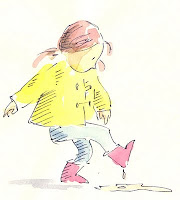
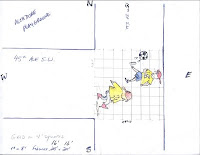
Calgary author, Simon Rose, and I have teamed up to do some work creative work on spec.
When Simon's not busy writing his next novel, and I'm not working on illustrations for my next children's picture book, we've been transforming Simon's manuscripts into book dummies -- or miniature picture books -- that we can then approach potential publishers with.
Our first foray was with a manuscript about a renaissance dragon -- a dragon who likes the finer things in life. We broke the copy up into pages, and I created draft images to accompany those pages. It's an interesting exercise, as you realize along the way what needs to be illustrated, what DOESN'T need to be illustrated and what copy is superfluous.
Here's the draft cover -- notice that everything's done in black & white, and very loosely rendered... the interior images are likewise. I scan all the images, and set the text i n Photoshop.
n Photoshop.
The beauty of creating a book dummy or a mock-up, is that you get an excellent feeling for the story's pacing and flow -- and most importantly, if the story is compelling enough to get readers to turn to the next page.
Another reason I like to make book dummies is that it makes a nice little package to hand over to a kid to critique-- whereas a sheet of thumbnails needs some explanation.
Our next project is about another fictional creature-- a little bigfoot -- who befriends a member of a different species. But more on that later...!
***Read more about Simon on his blog, or check out his site at www.simon-rose.com***
It's been quite a while since I've posted -- in fact, I had to figure out how to do it again.
In a nutshell, things have been very busy -- I just finished up my artist-in-residence at the Telus World of Science here in Calgary. My "thing" was old-fashioned optical devices, so had a zoetrope, flip-books and thaumatropes for visitors to muck around with.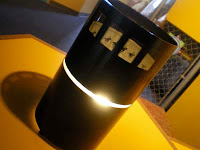
I really thought the zoetrope would get the most attention from kids (and I had nearly 600 of them in a 4 week period), but in fact, it was the thaumatropes that captured their attention.
In case you're wondering, a zoetrope looks like this pictured here ... this is the one from the Royal Saskatchewan Science Centre, but mine looked pretty similar. I had a local metal worker construct one for me. I think it was an unusual project for him.
Anyway, what was I saying...? Oh, yes-- it was the thaumatropes that the kids really dug. And do you know what they look like? Here's a pic for you... this is an example of a classic thaumatrope... empty bird cage on one side, bird on the other. Another classic example is the empty fish tank on one side, the fish on t'other.
bird cage on one side, bird on the other. Another classic example is the empty fish tank on one side, the fish on t'other.
Some of the ideas kids came in with were very inventive. Like a pile of logs on one side, and flames on the other, and when spun together, looked like a bonfire. A stick of dynamite on one side, a BOOM on the other. An uneaten chocolate bar on one side, a partially eaten one on the other. A blank TV set on one side, a character on the other... Some kids had trouble figuring out the upside down business, while others got it instantly.
Here's an example of a thaumatrope I did-- I call it the X-ray boy...
one side (right) is a boy, and on the other, very carefully lined up so that the eyes connect when the thaumatrope is spinning, is the skeleton.
Especially appropriate at Hallowe'en, which is when I was there.
My guest on today’s blog entry is Jacqueline Guest—at the time of this posting, Jacqueline has written 15 books for both kids and young adults. Jacqueline is a Metis writer who lives in a beautiful log cabin nestled in the foothills of the Rocky Mountains. Many of Jacqueline's main characters come from different ethnic backgrounds including First Nations, Inuit or Metis.
Q. I see your book War Games, has just come out. What’s it about?
A. War Games is the story of Ryan Taber, a video-addicted teen who thinks fun times have arrived when his iron-fisted father is deployed to Afghanistan with the military. Ryan's life spirals out of control as his video-gaming takes possession of him, and when his father comes home, Ryan is forced to choose between his virtual world and the real one.
Q. You’ve written lots of sports books – like Rink Rivals, Triple Threat and Hat Trick. Is sports your favourite genre? And I see that Soccer Star, the story of a 13-year old Inuit girl, won a Canadian Children’s Book Center Our Choice Award.
A. I like sports, but history is truly a big draw for me -- Belle of Batoche and Secret Signs are examples of a title in the history genre. I also really like mystery! Some of my novels are mysteries, like Dream Racer, Racing Fear and Lightening Rider.
Q. Where do you get your ideas from?
A. Everywhere!
Q. What did you read growing up?
A. Alice in Wonderland and A Child’s Book of Bible Verse. They were the only books I had and we didn’t have a library in our school or our town.
Q. I first met you at Almadina Language Charter School when you were the writer-in-residence. What did you work on with your students?
A. How to write the perfect story-- one that will make any examiner will give you high marks.
Q. When a student tells you that he or she wants to be a writer when they grow up, do you have any special advice?
A. The best way to become a writer is to be a reader. There is no substitute for reading-- it’s a writer’s best training tool.
Thank you very much for this interview, Jacqueline, and all the best with your latest book!
For more information about Jacqueline and her books, please visit jacquelineguest.com

Illustrating Words with Kids
A project I particularly love to bring into a classroom-- and which can take as little or as much time as you want-- is Illustrating Words. Adjectives are especially good for this exercise, but there’s no need to stop there.
I've found Grades 3 – 5 to be a good age for this exercise.
You’re familiar with Geronimo Stilton, right? Here’s an author/illustrator who pulls interesting, juicy words off of the page and launches them into the realm of illustration by way of interesting fonts.
What a great crossover—but of course, cartoonists like Will Eisner have been doing it for decades, using their art form to create totally unique fonts. In the world of comic books and graphic novels (and narrative art in general), words can be drawings and drawings can be words.
Whether you use this exercise in Language Arts or in Art, the effect is the same – kids get excited about words. If you decide to keep the exercise to adjectives only, you can r einforce what an adjective is and does-- students are describing a word that describes.
einforce what an adjective is and does-- students are describing a word that describes.
This exercise reminds of the famous real-life scene between Helen Keller and her teacher, Annie Sullivan, when Annie pulls Helen’s hand under an icy-cold, swiftly flowing water pump, while writing the word ‘water’ over and over in the palm of her hand.
Until this point in Helen’s life, she doesn’t understand what Annie’s so desperately trying to teach her, but this watershed  moment (sorry, no pun intended) opens Helen’s eyes (again, no pun intended), and she gets it BIG time.
moment (sorry, no pun intended) opens Helen’s eyes (again, no pun intended), and she gets it BIG time.
Where else can you take this exercise? How about getting kids to write paragraphs, or even stories, using this device? The juicier the word, the more fun they can have illustrating that word in the contex t of a story or paragraph. See some of my examples posted in this blog entry. (DIRTY was inspired by Pig Pen of Schulz' Peanuts cartoon.)
t of a story or paragraph. See some of my examples posted in this blog entry. (DIRTY was inspired by Pig Pen of Schulz' Peanuts cartoon.)
Here’s a sampling of words you might get your students to illustrate:
HOT, SNO
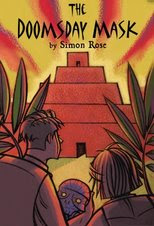 My guest today is science fiction and fantasy author Simon Rose, author of The Heretic's Tomb, The Emerald Curse, The Clone Conspiracy, The Sorcerer's Letterbox and The Alchemist's Portrait.
My guest today is science fiction and fantasy author Simon Rose, author of The Heretic's Tomb, The Emerald Curse, The Clone Conspiracy, The Sorcerer's Letterbox and The Alchemist's Portrait.
Q. Simon, in addition to your five books, do you have a new one coming out in 2009?
A. Yes, The Doomsday Mask (pictured) will be published this spring. It's once again for 8-12 age group, and in the science fiction and fantasy genre-- it's a fast-paced adventure about ancient civilizations, mysterious artifacts and shadowy secret societies. You can read its synopsis at http://www.simon-rose.com/doomsday.htm.
I've also another completed novel on a paranormal theme, numerous projects for future novels and am working on several picture books with a local illustrator.
Q. Where do you get your ideas from?
A. To be honest, anywhere and everywhere really... out walking the dog, driving in the car, something overheard in a conversation, a newspaper story, a billboard, an item on the evening news, other books, historical events, other people's stories, movies, or even something out of the blue. Some may never be used, but I try to record as many as I can. I never know when they might fit in with a story I'm writing. Even ideas that don't seem to work right away may have a use in the future.
Q. Why science fiction and fantasy?
A. One of the best things about writing for kids is that I can write about the kinds of things that fascinated me when I was young. Stories can be very imaginative if they are for children, which makes writing them so much fun. And, of course, in science fiction or fantasy, more or less anything you can imagine is possible, as you craft stories involving ancient mysteries, the unexplained, the paranormal, science fiction, time travel, parallel universes, alternate realities, weird and wonderful characters and a multitude of what if scenarios.
Q. What did you read growing up?
A. Lots of science fiction, as well fantasy writers and ghost stories. I also read a tremendous number of comic books, in which the stories took me across the universe, into strange dimensions, into the land of the Norse gods or had me swinging from the New York rooftops. At high school, I studied a lot of history and have retained my interest in the subject up to the present day. I also read voraciously on ancient civilizations, mysteries, the supernatural, and the unexplained.
Q. Now that you're all grown-up, do you visit schools and spend time with kids?
A. Yes, I offer a wide range of presentations workshops and author in residence programs for schools and libraries. I cover such topics as where ideas come from, story structure, editing and revision, character development, time travel stories, history and research, which you can learn more about at http://www.simon-rose.com/school_programs.htm
Q. What about adults? Do you ever work with them?
A. Yes, I conduct workshops on writing and publishing your children novel on a regular basis. I also offer editing and critiquing services and a number of online writing workshops, exploring where
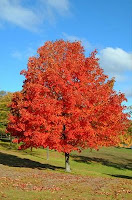 So, I find myself in a classroom with a bunch of adults looking back at me, and feel, well, a little self-conscious. I'm kinda used to looking at little faces, with kids asking kid-like questions, like "how old are you?", "what's your favourite colour?" and "what's your dog's name?" Instead, the questions were more mature, requiring more sophisticated answers from the instructor.
So, I find myself in a classroom with a bunch of adults looking back at me, and feel, well, a little self-conscious. I'm kinda used to looking at little faces, with kids asking kid-like questions, like "how old are you?", "what's your favourite colour?" and "what's your dog's name?" Instead, the questions were more mature, requiring more sophisticated answers from the instructor.
This was my first time planning a session for grown-ups -- a PD** session, to be specific . Since we only had half-a-day, I wanted to cram as many transferable techniques as possible into our short time frame. I decided I have them work with the grid method (they each had a nice picture of a tree, see red tree over there), which they'd transfer with graphite to a sheet of watercolour paper.
You know the grid method, I'm sure -- you draw a grid overtop of your original image -- in our case, the little red tree -- , and then a corresponding grid on a clean sheet. The corresponding grid can be either larger, smaller or the exact same size, depending on what you want -- do you want to enlarge your image? Smallen it (yes, that's a word)? OR, instead of drawing straight lines, make them all wobbly and uneven-- the end result can be pretty neat. You just want to make sure that each grid has the same number of squares. Then, start drawing, square by square, and watch your drawing come to life.
Once the tree was all drawn in pencil, we outlined the tree in ink -- I'd have preferred India Ink with a dip pen, but Sharpies did the trick. Then, after erasing all the graphite lines and smears, and letting the black ink dry, we moved into the watercolours. Lots of talk about the colour wheel, colour saturation, that sort of thing, et voila!, some fantastic looking pieces were the end result.
The teachers could then take what they'd learned that day and try it with their kids -- the grid method could be linked to the math curriculum, the other stuff to, well, the fine arts curriculum.
** Professional Development

I've started my artist-in-residency at Almadina Language Charter School in southeast Calgary, and have about 15 classes of grades 1 - 3. Our project over the next month is to illustrate stories the kids have written, either as a class or on an individual basis. My first visit was an introduction to the world of book illustration, about how I work, the process I follow, with lots of fun examples to show.
I've asked that the teachers have their stories written and ready to go -- no more than 150 words long -- and divided nicely into six pages. I devised a thumbnail sketch sheet for teachers to use with the kids prior to my return. Then, when I'm on the scene, I'll work one-on-one with the kids on their artwork.
A picture's worth a thousand words...
Once the copy is separated into pages and paired with the kids' drafty drawings, I want them to trade their thumbnails with a partner and have them read -- sort of a critiquing process. Does the story make sense? Are all those words really necessary? Do the pictures help move the story forward? Or are they just redundant (don't worry -- I'll find a better word than redundant...)?
More soon...
and here I'm writing again. Ya, I know -- it's about time.
Anyway, my latest children's book has now arrived on the scene, and it's called "Where Does Your Dog Sleep?" (published by Your Nickel's Worth Press). It's not a difficult book to read -- the fog index is set at about ages 1 - 5 -- so you needn't be intimidated. You can either buy it online at www.lairdbooks.com, or ask your local bookstore to bring it in.
My author is Jean Freeman (interesting aside, this is the second Freeman I've teamed up with -- no relation to one another), who plays Fitzi's Grandma on the CTV comedy, Corner Gas.
What else am I doing? Well, this month I'm artist-in-residence at Calgary's Almadina Language Charter Academy -- should be fun!
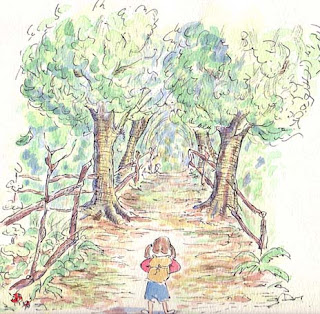
....that hasn't been said before? Well, I'm planning on palavering about drawing, about how much fun it can be, how frustrating it can be, what I do for research, illustrators whom I idolize, and so on ...
One thing I love doing is checking out the works of other illustrators, and I spend a lot of time poring over kids' books that appeal to me. I keep a list in my Palm Pilot, called "Illustrators and Titles I like," and refer to it (and the books) when work is slow. Here're a few that I especially adore (in they're in alphabetical order, too)...
Sergio Aragones (yes, of Mad Magazine), Edward Ardizzone (Tim series), Quentin Blake (esp. the Mrs Armitage series), Jean Claverie (Perfume of Memory, Little Lou), Janine Dawson (Parlez-moi!), Barbara Firth (Can't You Sleep Little Bear?), Sally Gardner (The glass heart; Tale of three princesses), Quentin Greban (Mommy I Love You, Dearest Little Mouse in the World, Un Cadeau pour Lea), Arther Howard (Mr Putter and Tabby series), Ann James (Dog in, Cat out), Simon James (Leon and Bob, Wildwood), Jill Barton (What Baby wants, Baby Duck series, Rattletrap Car), Kady MacDonald Denton, Helen Oxenbury, Jean Jacques Sempe (Le Petit Nicolas), Charlotte Voake, and last centuries' (okay, millenium's) Jessie Willcox Smith.
Whew. What do these illustrators have in common, you ask? Pure, clean lines, a proclivity** to abstractness, and obvious fearlessness when it comes to the blank page.
More later... ciao!
** I'm really hoping I spelled this right...
My 4 y/o son Charlie is a big jets fan (as are his parents) we live in sydney australia but his mum is from the 'peg. We showed him your pictures and he loved them, till now we have read the magic hockey skates over and over so it will be good to get a new book when we can track it down. In the meantime feel free to post a few more pages for us to look at, his mum was telling him how growing up she used to play hockey in the driveway and skate at the forks.
Thanks again
G'day Scott and Charlie --
I'm hoping that the Jets will be distributing The Home Team online.
I'll post a few more pics for you and Charlie to see on my Facebook page, which is at .
In the meantime, keep sending happy hockey season thoughts from down under!!
tks for your note!
Val
ooops... meant to write
www.facebook.com/vallawtonillustration
v